Assignment on Summative 2022
VerifiedAdded on 2022/10/01
|7
|1695
|20
Assignment
AI Summary
Contribute Materials
Your contribution can guide someone’s learning journey. Share your
documents today.
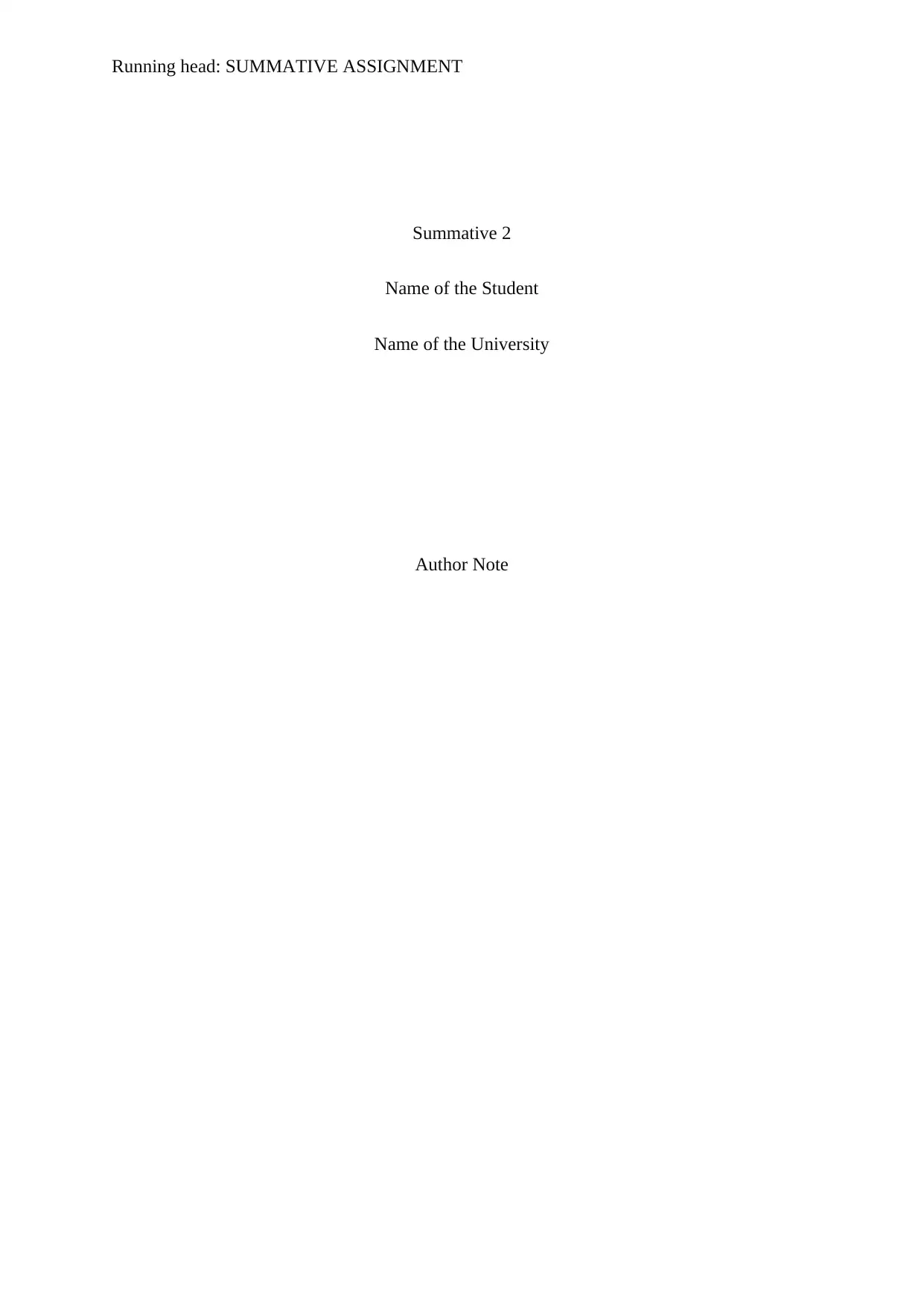
Running head: SUMMATIVE ASSIGNMENT
Summative 2
Name of the Student
Name of the University
Author Note
Summative 2
Name of the Student
Name of the University
Author Note
Secure Best Marks with AI Grader
Need help grading? Try our AI Grader for instant feedback on your assignments.
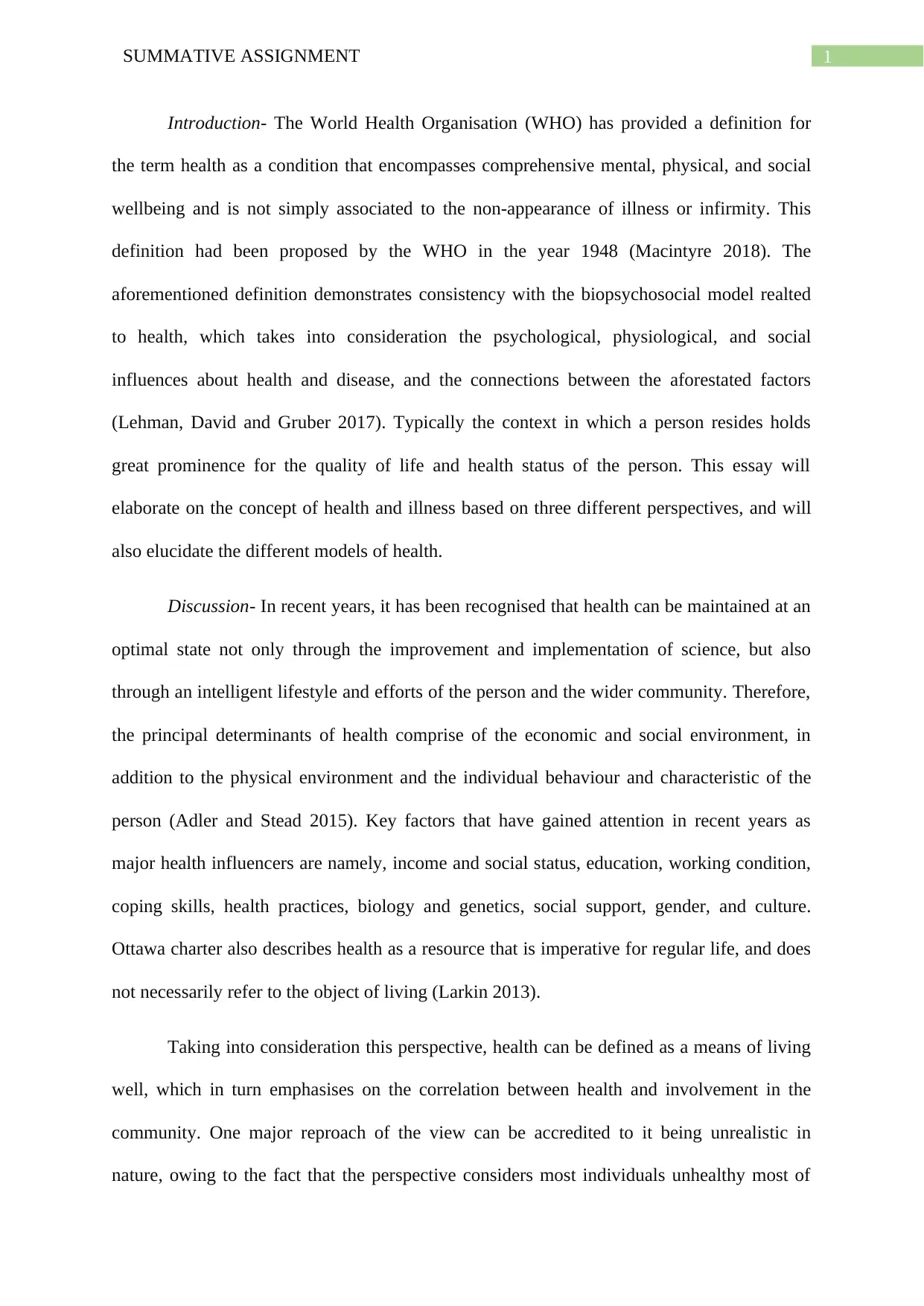
1SUMMATIVE ASSIGNMENT
Introduction- The World Health Organisation (WHO) has provided a definition for
the term health as a condition that encompasses comprehensive mental, physical, and social
wellbeing and is not simply associated to the non-appearance of illness or infirmity. This
definition had been proposed by the WHO in the year 1948 (Macintyre 2018). The
aforementioned definition demonstrates consistency with the biopsychosocial model realted
to health, which takes into consideration the psychological, physiological, and social
influences about health and disease, and the connections between the aforestated factors
(Lehman, David and Gruber 2017). Typically the context in which a person resides holds
great prominence for the quality of life and health status of the person. This essay will
elaborate on the concept of health and illness based on three different perspectives, and will
also elucidate the different models of health.
Discussion- In recent years, it has been recognised that health can be maintained at an
optimal state not only through the improvement and implementation of science, but also
through an intelligent lifestyle and efforts of the person and the wider community. Therefore,
the principal determinants of health comprise of the economic and social environment, in
addition to the physical environment and the individual behaviour and characteristic of the
person (Adler and Stead 2015). Key factors that have gained attention in recent years as
major health influencers are namely, income and social status, education, working condition,
coping skills, health practices, biology and genetics, social support, gender, and culture.
Ottawa charter also describes health as a resource that is imperative for regular life, and does
not necessarily refer to the object of living (Larkin 2013).
Taking into consideration this perspective, health can be defined as a means of living
well, which in turn emphasises on the correlation between health and involvement in the
community. One major reproach of the view can be accredited to it being unrealistic in
nature, owing to the fact that the perspective considers most individuals unhealthy most of
Introduction- The World Health Organisation (WHO) has provided a definition for
the term health as a condition that encompasses comprehensive mental, physical, and social
wellbeing and is not simply associated to the non-appearance of illness or infirmity. This
definition had been proposed by the WHO in the year 1948 (Macintyre 2018). The
aforementioned definition demonstrates consistency with the biopsychosocial model realted
to health, which takes into consideration the psychological, physiological, and social
influences about health and disease, and the connections between the aforestated factors
(Lehman, David and Gruber 2017). Typically the context in which a person resides holds
great prominence for the quality of life and health status of the person. This essay will
elaborate on the concept of health and illness based on three different perspectives, and will
also elucidate the different models of health.
Discussion- In recent years, it has been recognised that health can be maintained at an
optimal state not only through the improvement and implementation of science, but also
through an intelligent lifestyle and efforts of the person and the wider community. Therefore,
the principal determinants of health comprise of the economic and social environment, in
addition to the physical environment and the individual behaviour and characteristic of the
person (Adler and Stead 2015). Key factors that have gained attention in recent years as
major health influencers are namely, income and social status, education, working condition,
coping skills, health practices, biology and genetics, social support, gender, and culture.
Ottawa charter also describes health as a resource that is imperative for regular life, and does
not necessarily refer to the object of living (Larkin 2013).
Taking into consideration this perspective, health can be defined as a means of living
well, which in turn emphasises on the correlation between health and involvement in the
community. One major reproach of the view can be accredited to it being unrealistic in
nature, owing to the fact that the perspective considers most individuals unhealthy most of
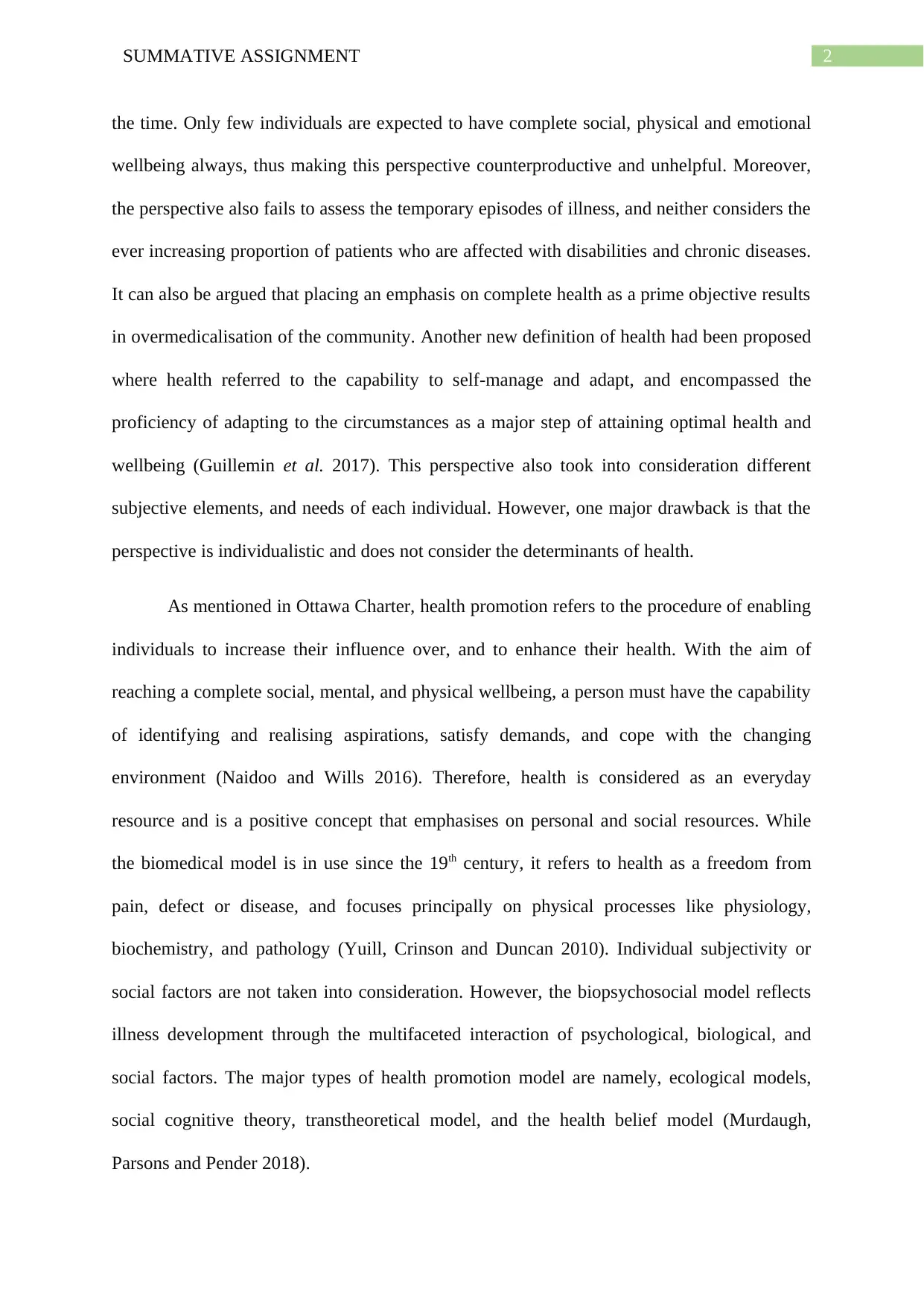
2SUMMATIVE ASSIGNMENT
the time. Only few individuals are expected to have complete social, physical and emotional
wellbeing always, thus making this perspective counterproductive and unhelpful. Moreover,
the perspective also fails to assess the temporary episodes of illness, and neither considers the
ever increasing proportion of patients who are affected with disabilities and chronic diseases.
It can also be argued that placing an emphasis on complete health as a prime objective results
in overmedicalisation of the community. Another new definition of health had been proposed
where health referred to the capability to self-manage and adapt, and encompassed the
proficiency of adapting to the circumstances as a major step of attaining optimal health and
wellbeing (Guillemin et al. 2017). This perspective also took into consideration different
subjective elements, and needs of each individual. However, one major drawback is that the
perspective is individualistic and does not consider the determinants of health.
As mentioned in Ottawa Charter, health promotion refers to the procedure of enabling
individuals to increase their influence over, and to enhance their health. With the aim of
reaching a complete social, mental, and physical wellbeing, a person must have the capability
of identifying and realising aspirations, satisfy demands, and cope with the changing
environment (Naidoo and Wills 2016). Therefore, health is considered as an everyday
resource and is a positive concept that emphasises on personal and social resources. While
the biomedical model is in use since the 19th century, it refers to health as a freedom from
pain, defect or disease, and focuses principally on physical processes like physiology,
biochemistry, and pathology (Yuill, Crinson and Duncan 2010). Individual subjectivity or
social factors are not taken into consideration. However, the biopsychosocial model reflects
illness development through the multifaceted interaction of psychological, biological, and
social factors. The major types of health promotion model are namely, ecological models,
social cognitive theory, transtheoretical model, and the health belief model (Murdaugh,
Parsons and Pender 2018).
the time. Only few individuals are expected to have complete social, physical and emotional
wellbeing always, thus making this perspective counterproductive and unhelpful. Moreover,
the perspective also fails to assess the temporary episodes of illness, and neither considers the
ever increasing proportion of patients who are affected with disabilities and chronic diseases.
It can also be argued that placing an emphasis on complete health as a prime objective results
in overmedicalisation of the community. Another new definition of health had been proposed
where health referred to the capability to self-manage and adapt, and encompassed the
proficiency of adapting to the circumstances as a major step of attaining optimal health and
wellbeing (Guillemin et al. 2017). This perspective also took into consideration different
subjective elements, and needs of each individual. However, one major drawback is that the
perspective is individualistic and does not consider the determinants of health.
As mentioned in Ottawa Charter, health promotion refers to the procedure of enabling
individuals to increase their influence over, and to enhance their health. With the aim of
reaching a complete social, mental, and physical wellbeing, a person must have the capability
of identifying and realising aspirations, satisfy demands, and cope with the changing
environment (Naidoo and Wills 2016). Therefore, health is considered as an everyday
resource and is a positive concept that emphasises on personal and social resources. While
the biomedical model is in use since the 19th century, it refers to health as a freedom from
pain, defect or disease, and focuses principally on physical processes like physiology,
biochemistry, and pathology (Yuill, Crinson and Duncan 2010). Individual subjectivity or
social factors are not taken into consideration. However, the biopsychosocial model reflects
illness development through the multifaceted interaction of psychological, biological, and
social factors. The major types of health promotion model are namely, ecological models,
social cognitive theory, transtheoretical model, and the health belief model (Murdaugh,
Parsons and Pender 2018).

3SUMMATIVE ASSIGNMENT
The ecological model identifies numerous levels of action on health behaviour such
as, interpersonal factors, intrapersonal factors, community factors, and institutional factors.
While intrapersonal factors encompass attitudes, beliefs, and personality, interpersonal
factors encompass interactions with other individuals that increases social support or results
in barriers. Moreover, informal or formal social norms existing in the community can also
enhance or limit healthy behaviour (Golden et al. 2015). One popular ecological model is
Project HEART (Health Education Awareness Research Team) that focuses on the
prevention of risk factors that are responsible for cardiovascular diseases. The Health Belief
model helps in explaining and predicting individual alterations in health behaviour and
focuses on perceived threat to disease, belief of consequence, perceived barriers, potential
positive benefits, and self-efficacy. This model helps in formulating short and long-term
interventions via five components namely, (i) information gathering, (ii) conveying health
issue consequences, (iii) communicating to target audience, (iv) providing support, and (v)
skill development (Skinner, Tiro and Champion 2015).
This is in contrast to the social cognitive theory (SCT) that defines the impact of
personal experiences, environmental factors and actions on individual health behaviour. SCT
also offers opportunities for community support by inculcating self-efficacy, expectations,
and using observational knowledge and other assistances to accomplish behaviour change.
Some other key components of SCT are namely, behavioural capability, expectancies, and
self-control. One such promotion program based on SCT is HoMBRes, which aims to
decrease risk of sexually transmitted disease and HIV amid Latino men, in remote regions of
the US (Rhodes et al. 2016). The transtheoretical model evaluates the readiness of an
individual to act on healthier behaviour, and also provides procedures of change and
strategies for guiding the person. This model comprises of constructs like change process,
change stage, change levels, decisional-balance, and self-efficacy. The smoking cessation
The ecological model identifies numerous levels of action on health behaviour such
as, interpersonal factors, intrapersonal factors, community factors, and institutional factors.
While intrapersonal factors encompass attitudes, beliefs, and personality, interpersonal
factors encompass interactions with other individuals that increases social support or results
in barriers. Moreover, informal or formal social norms existing in the community can also
enhance or limit healthy behaviour (Golden et al. 2015). One popular ecological model is
Project HEART (Health Education Awareness Research Team) that focuses on the
prevention of risk factors that are responsible for cardiovascular diseases. The Health Belief
model helps in explaining and predicting individual alterations in health behaviour and
focuses on perceived threat to disease, belief of consequence, perceived barriers, potential
positive benefits, and self-efficacy. This model helps in formulating short and long-term
interventions via five components namely, (i) information gathering, (ii) conveying health
issue consequences, (iii) communicating to target audience, (iv) providing support, and (v)
skill development (Skinner, Tiro and Champion 2015).
This is in contrast to the social cognitive theory (SCT) that defines the impact of
personal experiences, environmental factors and actions on individual health behaviour. SCT
also offers opportunities for community support by inculcating self-efficacy, expectations,
and using observational knowledge and other assistances to accomplish behaviour change.
Some other key components of SCT are namely, behavioural capability, expectancies, and
self-control. One such promotion program based on SCT is HoMBRes, which aims to
decrease risk of sexually transmitted disease and HIV amid Latino men, in remote regions of
the US (Rhodes et al. 2016). The transtheoretical model evaluates the readiness of an
individual to act on healthier behaviour, and also provides procedures of change and
strategies for guiding the person. This model comprises of constructs like change process,
change stage, change levels, decisional-balance, and self-efficacy. The smoking cessation
Secure Best Marks with AI Grader
Need help grading? Try our AI Grader for instant feedback on your assignments.
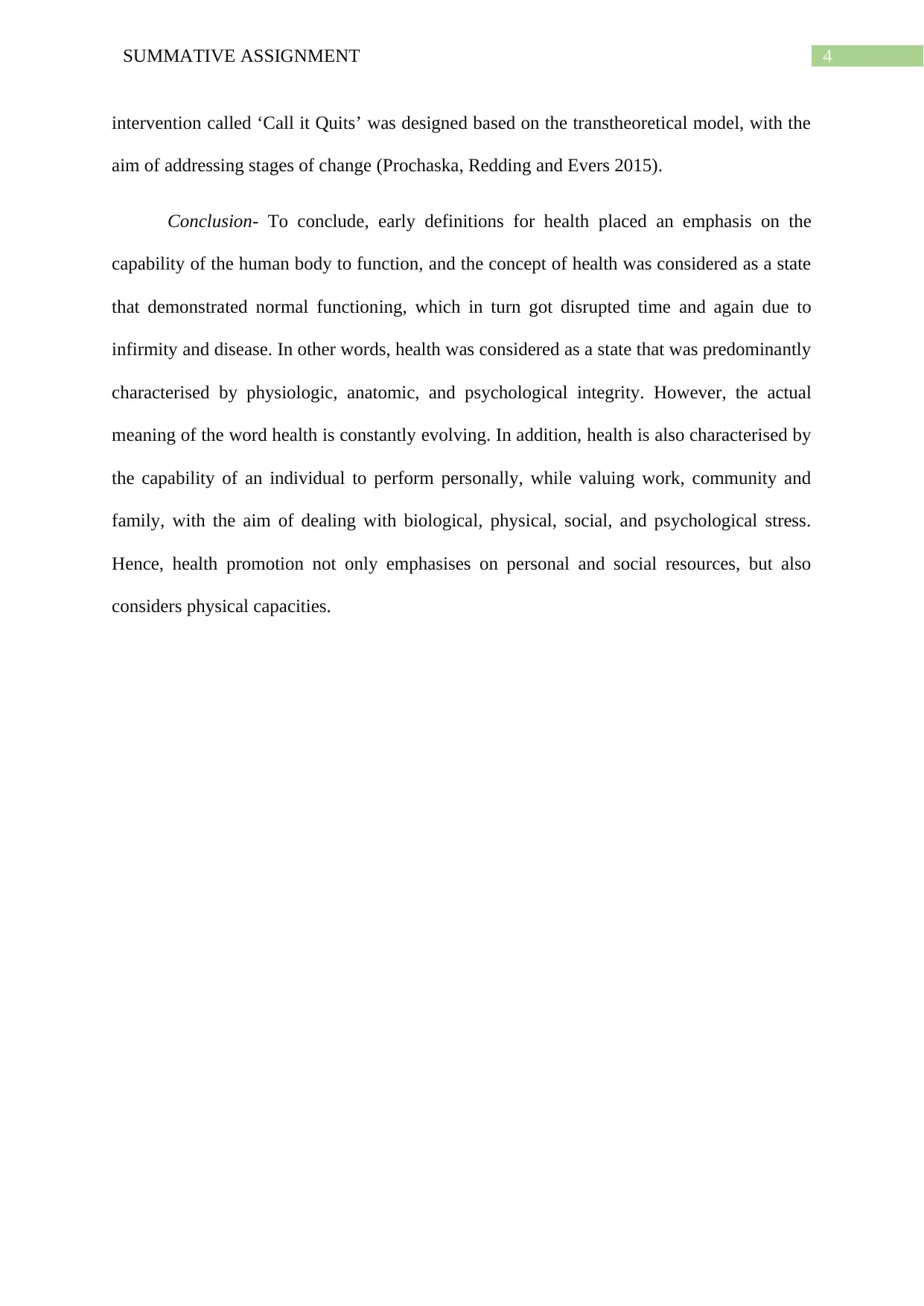
4SUMMATIVE ASSIGNMENT
intervention called ‘Call it Quits’ was designed based on the transtheoretical model, with the
aim of addressing stages of change (Prochaska, Redding and Evers 2015).
Conclusion- To conclude, early definitions for health placed an emphasis on the
capability of the human body to function, and the concept of health was considered as a state
that demonstrated normal functioning, which in turn got disrupted time and again due to
infirmity and disease. In other words, health was considered as a state that was predominantly
characterised by physiologic, anatomic, and psychological integrity. However, the actual
meaning of the word health is constantly evolving. In addition, health is also characterised by
the capability of an individual to perform personally, while valuing work, community and
family, with the aim of dealing with biological, physical, social, and psychological stress.
Hence, health promotion not only emphasises on personal and social resources, but also
considers physical capacities.
intervention called ‘Call it Quits’ was designed based on the transtheoretical model, with the
aim of addressing stages of change (Prochaska, Redding and Evers 2015).
Conclusion- To conclude, early definitions for health placed an emphasis on the
capability of the human body to function, and the concept of health was considered as a state
that demonstrated normal functioning, which in turn got disrupted time and again due to
infirmity and disease. In other words, health was considered as a state that was predominantly
characterised by physiologic, anatomic, and psychological integrity. However, the actual
meaning of the word health is constantly evolving. In addition, health is also characterised by
the capability of an individual to perform personally, while valuing work, community and
family, with the aim of dealing with biological, physical, social, and psychological stress.
Hence, health promotion not only emphasises on personal and social resources, but also
considers physical capacities.
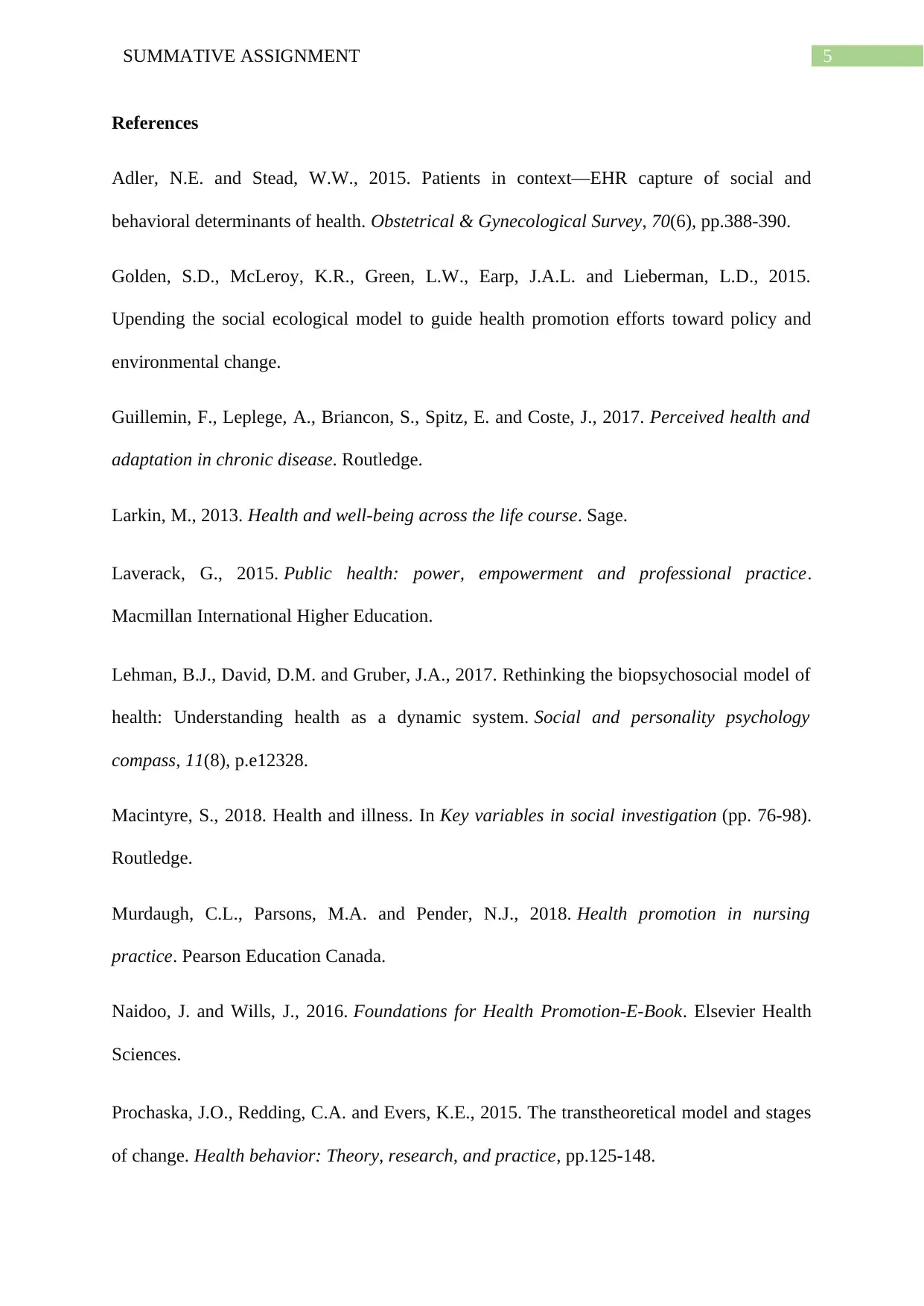
5SUMMATIVE ASSIGNMENT
References
Adler, N.E. and Stead, W.W., 2015. Patients in context—EHR capture of social and
behavioral determinants of health. Obstetrical & Gynecological Survey, 70(6), pp.388-390.
Golden, S.D., McLeroy, K.R., Green, L.W., Earp, J.A.L. and Lieberman, L.D., 2015.
Upending the social ecological model to guide health promotion efforts toward policy and
environmental change.
Guillemin, F., Leplege, A., Briancon, S., Spitz, E. and Coste, J., 2017. Perceived health and
adaptation in chronic disease. Routledge.
Larkin, M., 2013. Health and well-being across the life course. Sage.
Laverack, G., 2015. Public health: power, empowerment and professional practice.
Macmillan International Higher Education.
Lehman, B.J., David, D.M. and Gruber, J.A., 2017. Rethinking the biopsychosocial model of
health: Understanding health as a dynamic system. Social and personality psychology
compass, 11(8), p.e12328.
Macintyre, S., 2018. Health and illness. In Key variables in social investigation (pp. 76-98).
Routledge.
Murdaugh, C.L., Parsons, M.A. and Pender, N.J., 2018. Health promotion in nursing
practice. Pearson Education Canada.
Naidoo, J. and Wills, J., 2016. Foundations for Health Promotion-E-Book. Elsevier Health
Sciences.
Prochaska, J.O., Redding, C.A. and Evers, K.E., 2015. The transtheoretical model and stages
of change. Health behavior: Theory, research, and practice, pp.125-148.
References
Adler, N.E. and Stead, W.W., 2015. Patients in context—EHR capture of social and
behavioral determinants of health. Obstetrical & Gynecological Survey, 70(6), pp.388-390.
Golden, S.D., McLeroy, K.R., Green, L.W., Earp, J.A.L. and Lieberman, L.D., 2015.
Upending the social ecological model to guide health promotion efforts toward policy and
environmental change.
Guillemin, F., Leplege, A., Briancon, S., Spitz, E. and Coste, J., 2017. Perceived health and
adaptation in chronic disease. Routledge.
Larkin, M., 2013. Health and well-being across the life course. Sage.
Laverack, G., 2015. Public health: power, empowerment and professional practice.
Macmillan International Higher Education.
Lehman, B.J., David, D.M. and Gruber, J.A., 2017. Rethinking the biopsychosocial model of
health: Understanding health as a dynamic system. Social and personality psychology
compass, 11(8), p.e12328.
Macintyre, S., 2018. Health and illness. In Key variables in social investigation (pp. 76-98).
Routledge.
Murdaugh, C.L., Parsons, M.A. and Pender, N.J., 2018. Health promotion in nursing
practice. Pearson Education Canada.
Naidoo, J. and Wills, J., 2016. Foundations for Health Promotion-E-Book. Elsevier Health
Sciences.
Prochaska, J.O., Redding, C.A. and Evers, K.E., 2015. The transtheoretical model and stages
of change. Health behavior: Theory, research, and practice, pp.125-148.
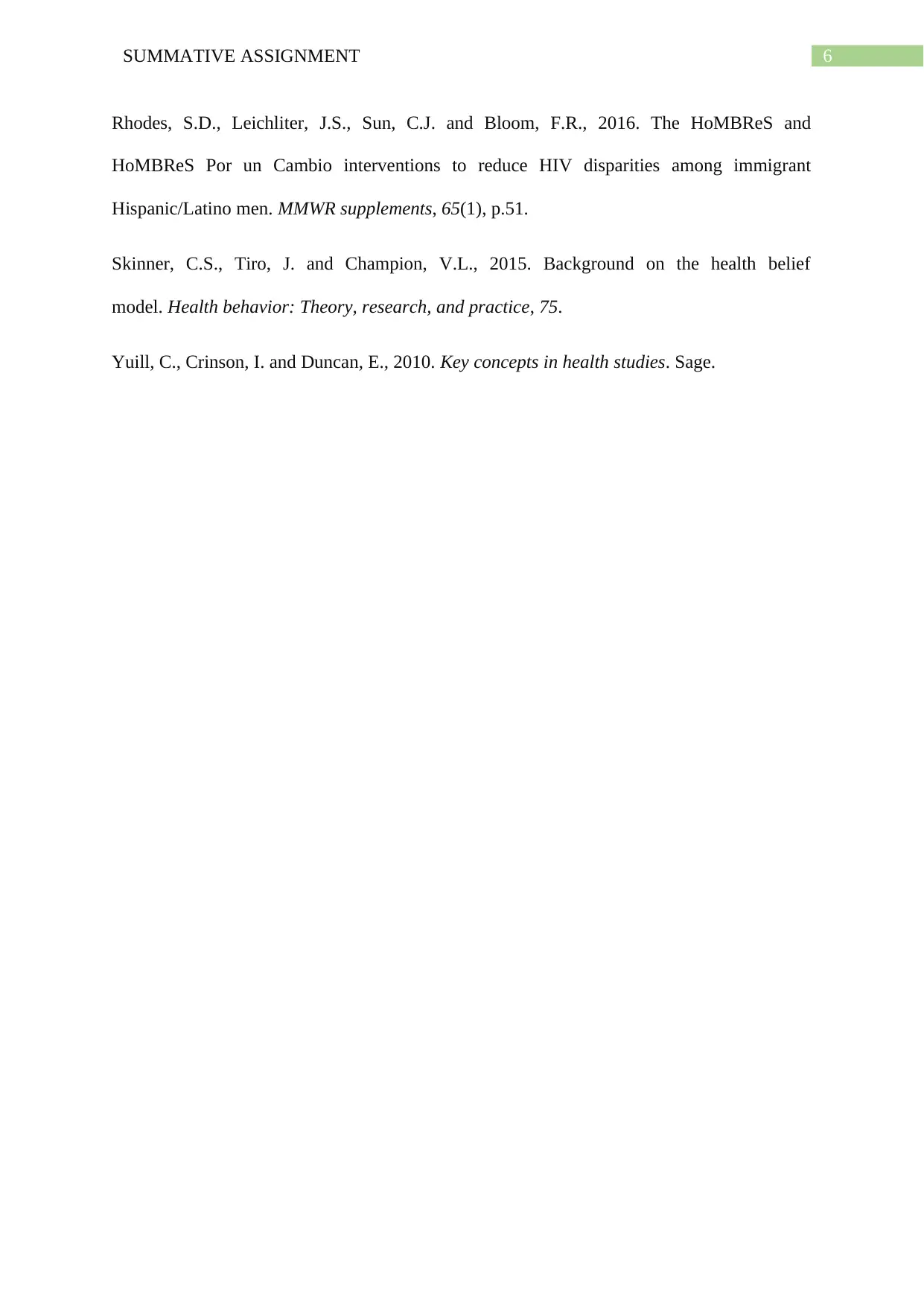
6SUMMATIVE ASSIGNMENT
Rhodes, S.D., Leichliter, J.S., Sun, C.J. and Bloom, F.R., 2016. The HoMBReS and
HoMBReS Por un Cambio interventions to reduce HIV disparities among immigrant
Hispanic/Latino men. MMWR supplements, 65(1), p.51.
Skinner, C.S., Tiro, J. and Champion, V.L., 2015. Background on the health belief
model. Health behavior: Theory, research, and practice, 75.
Yuill, C., Crinson, I. and Duncan, E., 2010. Key concepts in health studies. Sage.
Rhodes, S.D., Leichliter, J.S., Sun, C.J. and Bloom, F.R., 2016. The HoMBReS and
HoMBReS Por un Cambio interventions to reduce HIV disparities among immigrant
Hispanic/Latino men. MMWR supplements, 65(1), p.51.
Skinner, C.S., Tiro, J. and Champion, V.L., 2015. Background on the health belief
model. Health behavior: Theory, research, and practice, 75.
Yuill, C., Crinson, I. and Duncan, E., 2010. Key concepts in health studies. Sage.
1 out of 7
Related Documents
Your All-in-One AI-Powered Toolkit for Academic Success.
+13062052269
info@desklib.com
Available 24*7 on WhatsApp / Email
![[object Object]](/_next/static/media/star-bottom.7253800d.svg)
Unlock your academic potential
© 2024 | Zucol Services PVT LTD | All rights reserved.





